Hate crime, England and Wales, 2020 to 2021
Published 12 October 2021
Applies to England and Wales
Frequency of release: Annual
Forthcoming release: Home Office statistics release calendar
Home Office responsible statistician: John Flatley
Press enquires: pressoffice@homeoffice.gov.uk, Telephone: 0300 123 3535
Public enquires: crimeandpolicestats@homeoffice.gov.uk
This release contains statistics about hate crime offences recorded by the police in England and Wales.
Key results
- in year ending March 2021, there were 124,091 hate crimes recorded by the police in England and Wales
- excluding Greater Manchester Police who did not supply data for year ending March 2020 there was a 9 per cent increase compared with the previous year
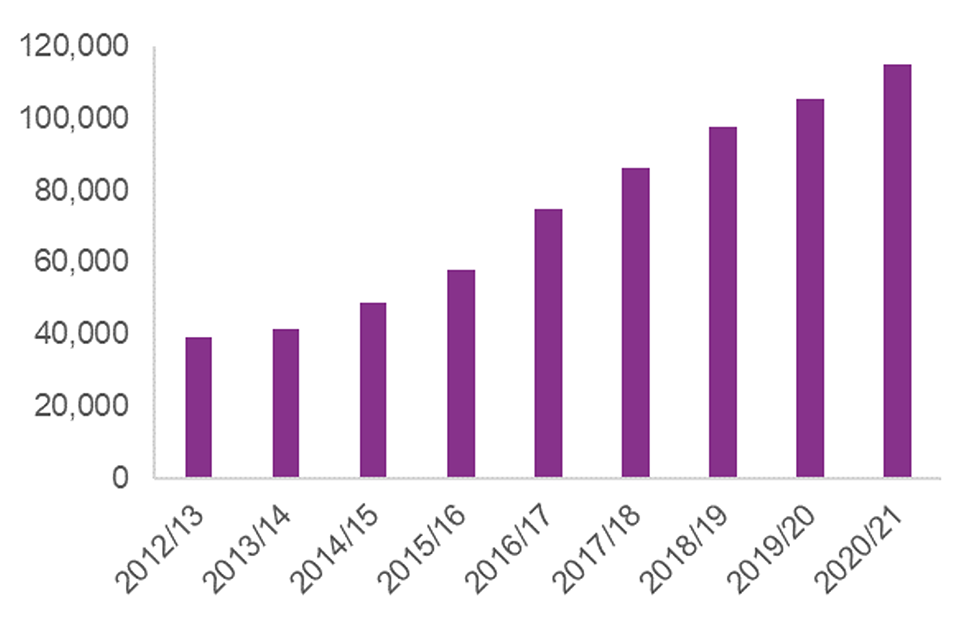
- increases in police recorded hate crime in recent years have been driven by improvements in crime recording and a better identification of what constitutes a hate crime
- as in previous years, the majority of hate crimes were racially motivated, accounting for around three-quarters of such offences (74%; 85,268 offences); these types of hate crime increased by 12 per cent between year ending March 2020 and year ending March 2021
1. Introduction
1.1 Overview
This statistical bulletin provides information on the number of hate crimes recorded by the police in England and Wales in year ending March 2021. Data for Greater Manchester Police have been excluded from any year-on-year comparisons within this bulletin as they were unable to supply data for year ending March 2020 following the implementation of a new IT system in July 2019.
1.2 Hate crimes recorded by the police
Hate crime is defined as ‘any criminal offence which is perceived, by the victim or any other person, to be motivated by hostility or prejudice towards someone based on a personal characteristic.’ This common definition was agreed in 2007 by the police, Crown Prosecution Service, Prison Service (now the National Offender Management Service) and other agencies that make up the criminal justice system. There are five centrally monitored strands of hate crime:
- race or ethnicity
- religion or beliefs
- sexual orientation
- disability
- transgender identity
In the process of recording a crime, the police can flag an offence as being motivated by one or more of these five monitored strands[footnote 1] for example, an offence can be motivated by hostility towards the victim’s race and religion). For more information, see Section 4 - Hate Crime data sources and quality. Hate crime figures in this bulletin are therefore dependent on a flag being correctly applied to an offence that is identified as a hate crime.
The College of Policing (CoP) published updated guidance on how the police should respond to hate crime in October 2020. The Authorised Professional Guidance on hate crime includes information on what can be covered by hate crime. The guidance states:
“A hate crime is any criminal offence which is perceived by the victim or any other person to be motivated by a hostility or prejudice based on:
- a person’s race or perceived race, or any racial group or ethnic background including countries within the UK and Gypsy and Traveller groups; this includes asylum seekers and migrants
- a person’s religion or perceived religion, or any religious group including those who have no faith
- a person’s sexual orientation or perceived sexual orientation, or any person’s sexual orientation
- a person’s disability or perceived disability, or any disability including physical disability, learning disability and mental health or developmental disorders
- a person who is transgender or perceived to be transgender, including people who are transsexual, transgender, cross dressers and those who hold a Gender Recognition Certificate under the Gender Recognition Act 2004
The inclusion of migrants within the first category listed above means that offences with a xenophobic element (such as graffiti targeting certain nationalities) can be recorded as race hate crimes by the police.
An offence may also be motivated by hatred towards a characteristic (strand) that is not currently centrally monitored and therefore does not form part of the data collection presented in this statistical bulletin (age or gender for example).
Hate crimes are taken to mean any crime where the perpetrator’s hostility or prejudice against an identifiable group of people is a factor in determining who is victimised. While a crime may be recorded as a ‘hate crime’, it may only be prosecuted as such if evidence of hostility is submitted as part of the case file.
Terrorist offences may or may not be considered a hate crime depending on the circumstances. A terrorist attack may be targeted against general British or Western values rather than one of the five specific strands. Attacks of this nature are therefore not covered by this statistical bulletin, although they will clearly be motivated by hate. However, other terrorist attacks are motivated by a hatred towards one of the centrally monitored hate crime strands covered by this statistical bulletin. For example, the Finsbury Park Mosque attack in June 2017 has been classified as a hate crime because the victims were thought to be targeted because of their religious affiliation.
The Law Commission is considering proposals to reform hate crime laws to remove the disparity in the way hate crime laws treat each protected characteristic – race, religion, sexual orientation, disability and transgender identity and are due to report their recommendations later in 2021. Any proposals by the Law Commission may lead to future changes in the future coverage of the monitored strands.
1.3 Hate crimes and racially or religiously aggravated offences
There are some offences in the main police recorded crime collection which have a specific racially or religiously motivated elements defined by statute. These constitute a set of offences which are distinct from their non-racially or religiously aggravated equivalents (the full list of these is shown in List 1.1). These racially or religiously aggravated offences are, by definition, hate crimes. Just over half (53%) of hate crime offences are recorded as one of these racially or religiously aggravated offences.
List 1.1 The five racially or religiously aggravated offences and their non-aggravated equivalents
Racially or religiously aggravated offences
Offence code 8P
Offence description Racially or religiously aggravated assault with injury
Non-aggravated equivalent offences
Offence code 8N
Offence description Assault with injury
Racially or religiously aggravated offences
Offence code 105B
Offence description Racially or religiously aggravated assault without injury
Non-aggravated equivalent offences
Offence code 105A
Offence description Assault without injury
Racially or religiously aggravated offences
Offence code 8M
Offence description Racially or religiously aggravated harassment
Non-aggravated equivalent offences
Offence code 8L
Offence description Harassment
Racially or religiously aggravated offences
Offence code 9B
Offence description Racially or religiously aggravated public fear, alarm or distress
Non-aggravated equivalent offences
Offence code 9A
Offence description Public fear, alarm or distress
Racially or religiously aggravated offences
Offence code 58J
Offence description Racially or religiously aggravated criminal damage
Non-aggravated equivalent offences
Offence code 58A
Offence description Criminal damage to a dwelling
Offence code 58B
Offence description Criminal damage to a building other than a dwelling
Offence code 58C
Offence description Criminal damage to a vehicle
Offence code 58D
Offence description Other criminal damage
Source: Police recorded crime, Home Office
1.4 Crime survey for England and Wales (CSEW)
The CSEW is a face-to-face victimisation survey and also provides information on hate crimes experienced by people resident in England and Wales. However, the size of the CSEW sample means the number of hate crime incidents and victims estimated in a single survey year is too unreliable to report on. Therefore, three annual datasets are combined to provide a larger sample which can be used to produce robust estimates for hate crime. Estimates from the survey were last published in ‘Hate Crime, England and Wales, 2019 to 2020’. The next publication of figures from the CSEW would have been due in 2023, but this may be delayed because the face-to-face survey was suspended due to public health restrictions during the COVID-19 pandemic.
2. Police recorded hate crime
Key results
- in year ending March 2021, there were 124,091 hate crimes recorded by the police in England and Wales; of which there were 92,052 race hate crimes, 6,377 religious hate crimes, 18,596 sexual orientation hate crimes, 9,943 disability hate crimes and 2,799 transgender hate crimes
- excluding Greater Manchester Police[footnote 2], who did not supply data for year ending March 2020, there were 114,958 hate crimes recorded by the police in England and Wales in year ending March 2021, an increase of nine per cent compared with year ending March 2020 (105,362 offences); while increases in hate crime over the last five years have been mainly driven by improvements in crime recording by the police, there has been spikes in hate crime following certain events such as the EU Referendum and the terrorist attacks in 2017
- as in previous years, the majority of hate crimes were racially motivated, accounting for around three-quarters of all such offences (74%; 85,268 offences); racially motivated hate crimes increased by 12 per cent between year ending March 2020 and year ending March 2021
- religious hate crimes fell by 18 per cent (to 5,627 offences), down from 6,856 in the previous year; this was the second successive fall in religious hate crimes since a peak of 7,202 offences in year ending March 2019
- sexual orientation hate crimes increased seven per cent (to 17,135), disability hate crimes by nine per cent (to 9,208) and transgender identity hate crimes by three per cent (to 2,630); these percentage increases were smaller than seen in recent years
- over half (52%) of the hate crimes recorded by the police were for public order offences and a 40% were for violence against the person offences; five per cent were recorded as criminal damage and arson offences
2.1 Prevalence and trends
Police forces have made significant improvements in how they record crime since 2014. They have also improved their identification of what constitutes a hate crime. Because of these changes, police recorded crime figures do not currently provide reliable trends in hate crime. The figures do, however, provide a good measure of the hate crime-related demand on the police. For more information, see the Police recorded hate crime data sources and quality.
Hate crimes are a subset of notifiable offences recorded by the police. In year ending March 2021, three per cent of such offences recorded by the police were identified as being hate crimes. This proportion has gradually increased from one per cent in year ending March 2013, as the police have improved their identification of what constitutes a hate crime.
There were 124,091 hate crimes recorded by the police in England and Wales in year ending March 2021. Excluding Greater Manchester Police, who were unable to provide data for year ending March 2020 following the implementation of a new IT system in July 2019, there were 114,958 hate crimes, an increase of nine per cent compared with year ending March 2020 (105,362 offences; see Table 2.1).
Religious hate crimes fell by 18 per cent (from 6,856 to 5,627) which was the second consecutive fall in these offences and down from a peak in year ending March 2019 (when there were 7,202 offences). There were increases other categories of hate crime including in sexual orientation (up 7%), disability (9%) and transgender identity (3%) over the last year. However, these percentage changes were lower than seen in recent years.
The increases seen over the last six years are thought to have been driven by improvements in crime recording by the police following a review by HM Inspectorate of Constabulary and Fire & Rescue Services (HMICFRS)[footnote 3] in 2014 and the removal of the designation of police recorded crime as National Statistics[footnote 4]. It also thought that growing awareness of hate crime is likely to have led to improved identification of such offences.
Although these improvements are thought to be the main drivers for the increases seen, there appear to have been short-term genuine rises in hate crime following certain trigger events. Increases in hate crime were seen around the EU Referendum in June 2016 and the terrorist attacks in 2017. There was also an increase in public order hate crimes during the summer of 2020 following the widespread Black Lives Matter protests and far-right counter-protests.
Table 2.1: Hate crimes recorded by the police by monitored strand, year ending March 2016 to year ending March 2020
| Numbers and percentages | England and Wales | |||||
|---|---|---|---|---|---|---|
| Hate crime strand | 2016/17 | 2017/18 | 2018/19 | 2019/20 | 2020/21 | % change 2019/20 to 2020/21 |
| Race | 58,294 | 64,829 | 72,051 | 76,158 | 85,268 | 12 |
| Religion | 5,184 | 7,103 | 7,202 | 6,856 | 5,627 | -18 |
| Sexual orientation | 8,569 | 10,670 | 13,311 | 15,972 | 17,135 | 7 |
| Disability | 5,254 | 6,787 | 7,786 | 8,465 | 9,208 | 9 |
| Transgender | 1,195 | 1,615 | 2,185 | 2,542 | 2,630 | 3 |
| Total number of motivating factors | 78,496 | 91,004 | 102,535 | 109,993 | 119,868 | 9 |
| Total number of offences | 74,967 | 86,254 | 97,474 | 105,362 | 114,958 | 9 |
Source: Police recorded crime, Home Office. Figures exclude GMP.
See Bulletin Table 2 for detailed footnotes
It is possible for a crime to have more than one motivating factor (for example an offence may be motivated by hostility towards both the victim’s race and religion). Thus, as well as recording the overall number of hate crimes, the police also collect data on the number of motivating factors by strand as shown in Table 2.1. For this reason, the sum of the five motivating factors in the above exceeds the 114,958 overall hate crime offences recorded by the police. Around five per cent of hate crime offences in year ending March 2021 were estimated to have involved more than one motivating factor[footnote 5].
Hate crime data by Police Force Area from year year ending March 2012 to year ending March 2021 can be found in the Home Office Police recorded crime and outcomes open data tables.
Section 2.2 shows that 92 per cent of hate crimes in year ending March 2021 were for either public order or violence against the person offences, continuing the pattern seen in previous years. These are two offence groups thought to have been previously subject to relatively high levels of under-recording and thus improvements in crime recording is likely to have had a larger impact on these groups than other offences. Figure 2.1 shows the indexed trend in overall violent and public order offences since year ending March 2013 compared with all hate crime offences over the same period. As can be seen, there is a strong correlation between the increase in overall public order and violence against the person offences and hate crime.
In contrast, the Crime Survey for England and Wales (CSEW)[footnote 6], which covers offences not reported to the police[footnote 7] unaffected by changes in recording practice, shows a fall in hate crime over the last decade. According to the CSEW, the estimated number of hate crime incidents experienced by adults aged 16 and over fell from 307,000 in the combined year ending March 2008 and year ending March 2009 surveys to 190,000 in the combined year ending March 2018, year ending March 2019 and year ending March 2020 surveys, a fall of 38 per cent. However, due to the combined survey years the CSEW is not able to identify changes in hate crime over shorter-term periods.
Figure 2.1: Indexed trends in the number of police recorded violence against the person and public order and hate crime offences, year ending March 2013 to year ending March 2021 (year ending March 2013 = 100)

Source: Police recorded crime, Home Office. Figures exclude GMP.
Religious hate crimes
In April 2016, the Home Office began collecting information from the police on the perceived religion of victims of religious hate crime. By perceived, we mean the religion targeted by the offender. While in the majority of offences the perceived and actual religion of the victim will be the same, in some cases they will differ. For example, if anti-Muslim graffiti is sprayed on a religious temple of another faith, this would be recorded as an offence of racially or religiously aggravated criminal damage and flagged by the respective police force as a religious hate crime against Muslims.
There are nine different perceived religion flags in this collection, which match those reported upon in the 2021 Census:
- Buddhist
- Christian
- Hindu
- Jewish
- Muslim
- Sikh
- other
- no religion
- unknown
Of the 6,377 religious hate crimes recorded by the police in year ending March 2021 (including Greater Manchester Police), information on the targeted religion was provided in 5,948 of the offences (93%)[footnote 8].
In some cases, more than one perceived religion had been tagged on one offence (for example, a piece of graffiti may have targeted more than one religion). All police forces sent data on the perceived religion of the victims of religious hate crimes (with the exception of Nottinghamshire, who were unable to provide these data for year ending March 2021), although for some forces the number of offences recorded with ‘unknown religion’ was relatively high.
In year ending March 2021, where the perceived religion of the victim was recorded, just under half (45%) of religious hate crime offences were targeted against Muslims (2,703 offences). The next most commonly targeted group were Jewish people, who were targeted in 22 per cent of religious hate crimes (1,288 offences). These proportions were similar to the previous year.
In 16 per cent of offences, the targeted religion was not known. Information on the other targeted religions for year ending March 2021 can be found in Table 2.2.
Table 2.2: Number and proportion of religious hate crimes recorded by the police1, by the perceived targeted religion, year ending March 2020
| Numbers and percentages | England and Wales | |
|---|---|---|
| Perceived religion of the victim | Number of offences 2020/21 | % 2020/21 |
| Buddhist | 23 | 0 |
| Christian | 521 | 9 |
| Hindu | 166 | 3 |
| Jewish | 1,288 | 22 |
| Muslim | 2,703 | 45 |
| Sikh | 112 | 2 |
| Other | 351 | 6 |
| No religion | 174 | 3 |
| Unknown | 926 | 16 |
| Total number of targeted religions | 6,264 | |
| Total number of offences | 5,948 |
Source: Police recorded crime, Home Office. Figures exclude Nottinghamshire.
See Bulletin Table 3 for detailed footnotes.
1. In some offences more than one religion has been recorded as being targeted, therefore the sum of the proportions do not add to 100%.
Racial or religiously aggravated offences
The data the Home Office receives in the main police recorded crime return for racially or religiously aggravated offences are available on a monthly basis[footnote 9]. This allows in-year trend in these offences to be seen around the time of particular incidents. An indexed chart of these offences and their non-aggravated equivalent offence are shown in (Figure 2.2). There are three clear spikes in these aggravated offences which were not seen in the non-aggravated offences: July 2016, following the EU Referendum, July 2017, following the terrorist attacks seen in this year, and in Summer 2020, following the Black Lives Matter protests and far-right counter-protests following the death of George Floyd on 25th May in the United States of America. There are also spikes in July 2018 and 2019, but these follow the same trend as for the non-aggravated offences.
Figure 2.2: Indexed number of racially or religiously aggravated offences recorded by the police by month, April 2015 to March 2021
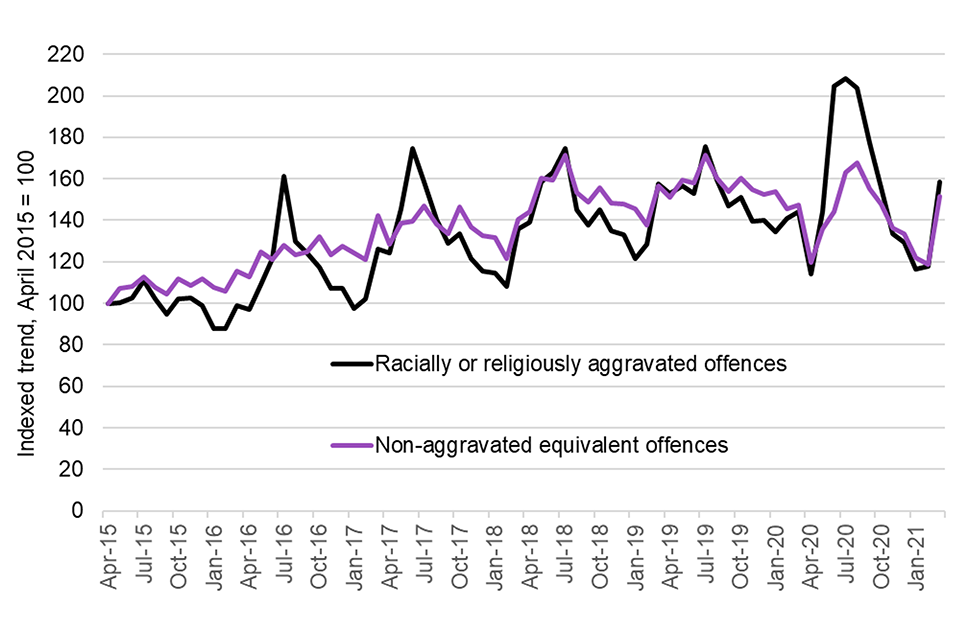
Source: Police recorded crime, Home Office.
2.2 Hate crimes by type of offence
Data in this section covers year ending March 2021 and includes figures for Greater Manchester Police. Over half (52%) of the hate crimes recorded by the police were for public order offences and over a third (40%) were for violence against the person offences (Figure 2.3; Bulletin Table 6). Together, these offence categories accounted for just over nine in ten (92%) of all hate crimes recorded by the police.
Figure 2.3: Distribution of offences flagged as hate crimes, year ending March 2021
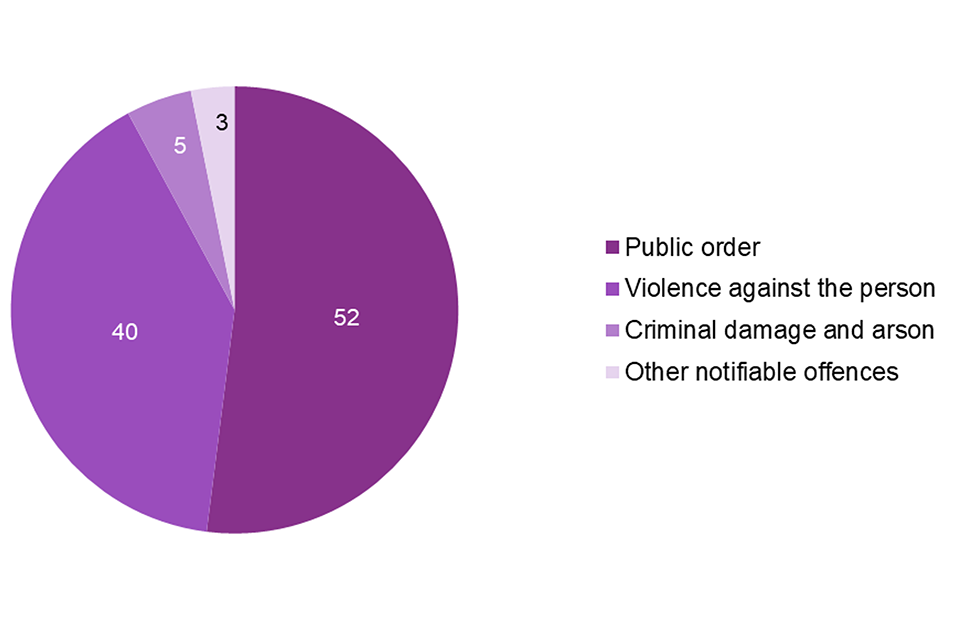
Source: Police recorded crime, Home Office.
The distribution of hate crime offences differs markedly from overall police recorded crime. Theft offences accounted for just under a third (28%) of all recorded crime in year ending March 2021; these offences are unlikely to involve a motivating factor against a monitored strand. In contrast, public order offences accounted for just ten per cent of all notifiable offences compared with 52 per cent of hate crime offences (Figure 2.4).
Figure 2.4: Breakdown of hate crimes and overall recorded crime by selected offence types, year ending March 2021

Source: Police recorded crime, Home Office.
Figure 2.5 shows what type of offences are being recorded for each monitored strand. As in previous years, public order offences were the most common offence to be recorded for all strands.
Figure 2.5: Breakdown of hate crime by selected offence types and monitored strand, year ending March 2021
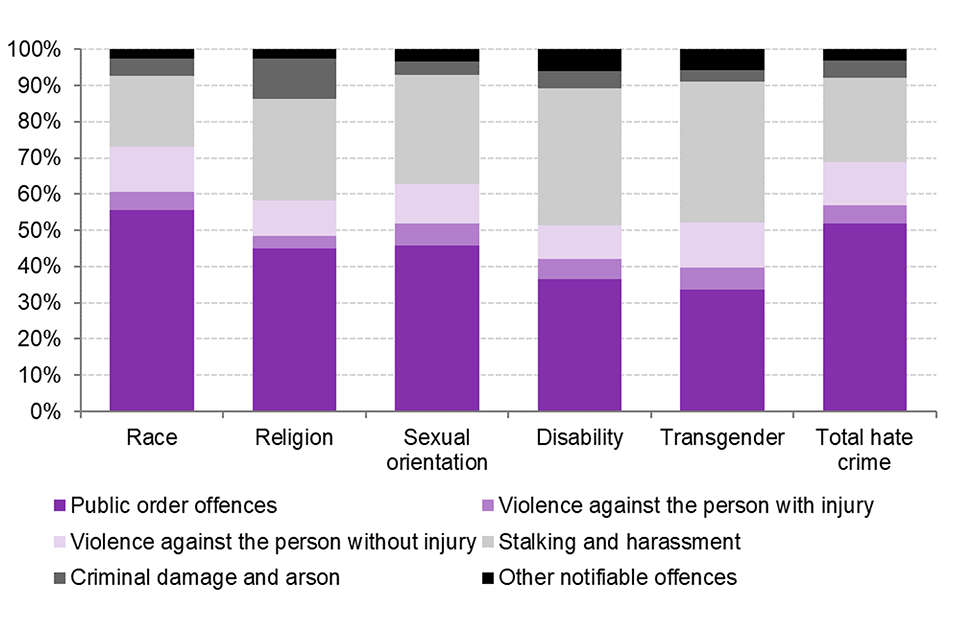
Source: Police recorded crime, Home Office.
2.3 Hate crime outcomes
The Home Office collects information on the investigative outcomes of police recorded offences, including those that are identified as hate crimes. For further information on outcomes see Crime Outcomes in England and Wales: Year ending March 2021.
This section covers how the police have dealt with hate crimes recorded in the year ending March 2021. This analysis is based on the outcomes assigned to crimes recorded in year ending March 2021 at the time the data were extracted (June 2021) for analysis. Some offences will not have been assigned an outcome at this time and therefore these figures are subject to change.
Racially or religiously aggravated offence outcomes
Data presented in this section are for racially or religiously aggravated offences. These data were available for all police forces. Data on outcomes for all hate crime offences, which were available for 26 of the 44 police forces[footnote 10], are presented in the next section.
At the time these data were extracted, 89 per cent of racially or religiously aggravated offences had been assigned an outcome compared with 94 per cent of their non-aggravated counterparts (data not shown).
Figure 2.6 shows that racially or religiously aggravated offences were more likely to be dealt with by a charge or summons than their non-aggravated counterparts, reflecting the serious nature of racially or religiously aggravated offences. For example, twice the proportion of racially or religiously aggravated public fear, alarm and distress offences had been dealt with by charge or summons than the non-aggravated equivalent offences (13% and 6% respectively).
Figure 2.6: Percentage of racially or religiously aggravated offences and their non-aggravated equivalents recorded in year ending March 2021 resulting in charge or summons, by offence type
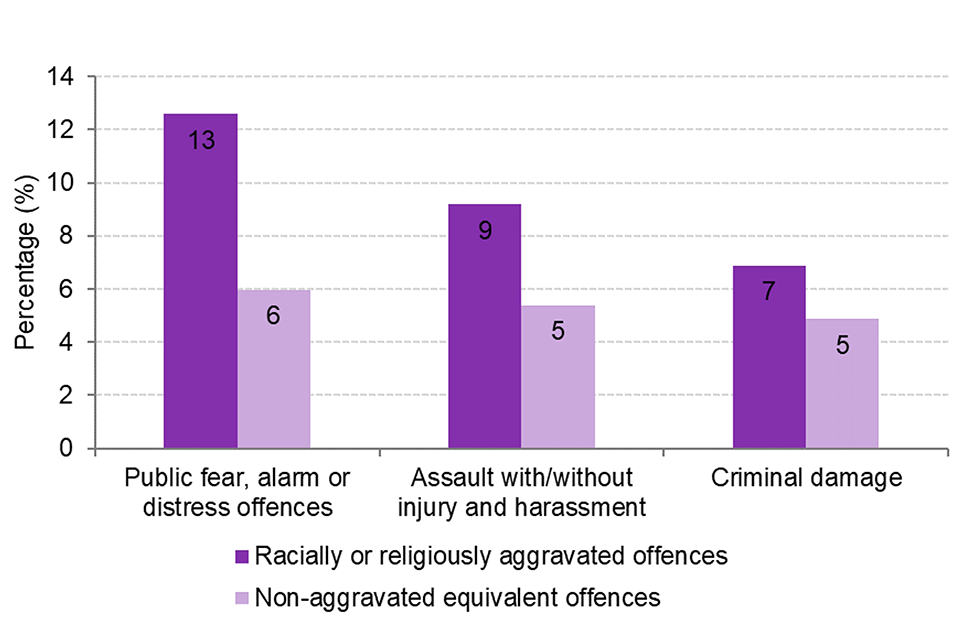
Source: Police recorded crime, Home Office.
The overall proportion of racially or religiously aggravated offences resulting in a charge or summons was 11.6%, higher than the figure for year ending March 2020 at the time of publication last year (10.7%). This increase was due to a 1.6 percentage point increase in the proportion of racially or religiously aggravated public fear, alarm or distress offences being assigned a charge or summons outcome, from 11.0% to 12.6% (data not shown). This increase has halted a previous downward trend seen since the introduction of the Outcomes Framework in year ending March 2015, when, for example, 30% of racially or religiously aggravated public fear, alarm or distress offences were resolved by a charge or summons. As explained in the ‘Crime outcomes, England and Wales, 2020 to 2021’ statistical bulletin, the volumes of charges had been falling in recent years at the same time as volume of crimes recorded by the police has risen. This pattern was also observed in racially or religiously aggravated offences. There is evidence to suggest that a higher proportion of recorded crimes in recent years were for offence types which can be more challenging to investigate. This means that the investigative caseload has both grown and become more complex.
Flagged hate crime offences – Home Office Data Hub
The Home Office have implemented an improved data collection system called the Home Office Data Hub which is designed to streamline the process by which forces submit data. The Data Hub replaces the old system by capturing record-level crime data via direct extracts from forces’ own crime recording systems. This allows the police to provide more detailed information to the Home Office enabling a greater range of analyses to be carried out.
Using the Data Hub, it is possible to see how offences flagged as being motivated by one or more of the five monitored strands have been dealt with by the police. The analyses presented are based on data from 26[footnote 11] of the 44 police forces in England and Wales that supplied adequate data to the Data Hub; these forces data accounted for around two-thirds (66%) of all police recorded hate crime in year ending March 2021.
In total, 91 per cent of hate crime flagged offences recorded in year ending March 2021 had been assigned an outcome at the time the data were extracted from the Data Hub[footnote 12]. The remaining nine per cent were still under investigation. Similarly, 92 per cent of non-hate crime offences had been assigned an outcome at the time of data extraction (data not shown).
Appendix Table 4 shows that ten per cent of all hate crime flagged offences had been dealt with by a charge or summons, up from the published figure of nine per cent in year ending March 2020. As with racially or religiously aggravated offences, the proportion of offences dealt with by charge or summons had been falling since the introduction of the Outcomes Framework.
The offences recorded by the police that constitute hate crimes were very different to overall crime. Therefore, to provide more meaningful comparisons charge or summons rates are shown below for certain offence groups.
Figure 2.4 shows that violence against the person, public order offences and criminal damage and arson offences comprised 97 per cent of hate crime flagged offences. This proportion is the same for the 26 forces included in this analysis, suggesting that these forces are broadly representative of all.
The proportions of outcomes assigned varied by offence type (Appendix Table 5; Figure 2.7):
- eight per cent of violence against the person hate crime flagged offences, and seven per cent of criminal damage and arson hate crime flagged offences, were dealt with by a charge or summons, similar proportions to non-flagged offences (7% and 5% respectively)
- a greater proportion (12%) of hate crime flagged public order offences had been dealt with by a charge or summons compared with non-hate crime flagged public order offences (8%)
Figure 2.7: Percentage of selected offences dealt with by a charge or summons, offences recorded in year ending March 2021, 26 forces
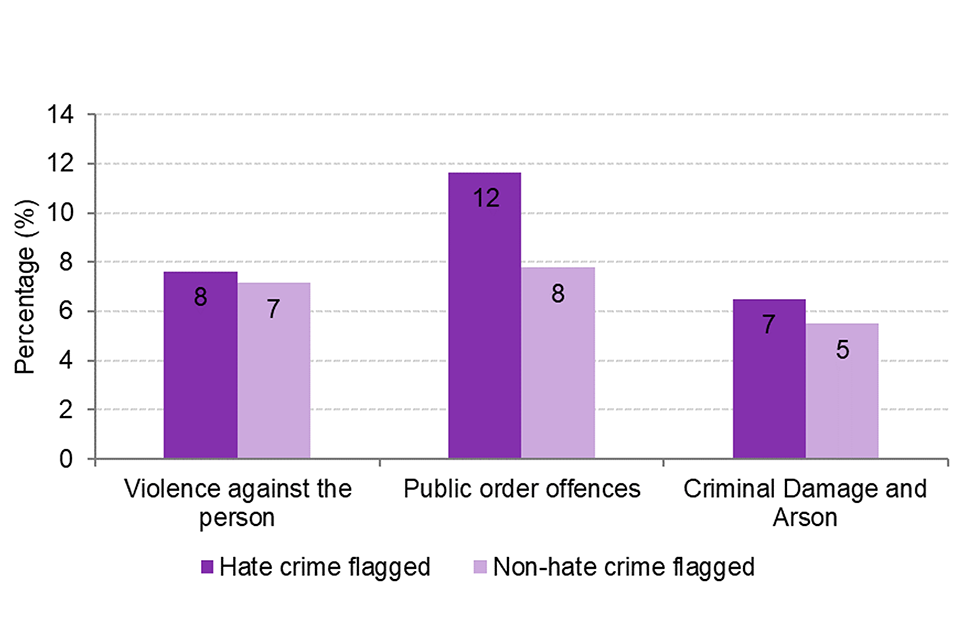
Source: Police recorded crime, Home Office Data Hub.
The most frequent outcome recorded for violent offences was “evidential difficulties as the victim does not support action”; this was the outcome for 32 per cent of hate crime flagged violence against the person offences compared with 44 per cent of non-hate crime flagged offences (Appendix Table 5).
Figure 2.8 shows the proportion of hate crimes that were dealt with by charge or summons for each of the five hate crime strands for three offence groups.
Figure 2.8: Percentage of selected offences resulting in charge or summons, by hate crime strand, offences recorded in year ending March 2021, 26 forces
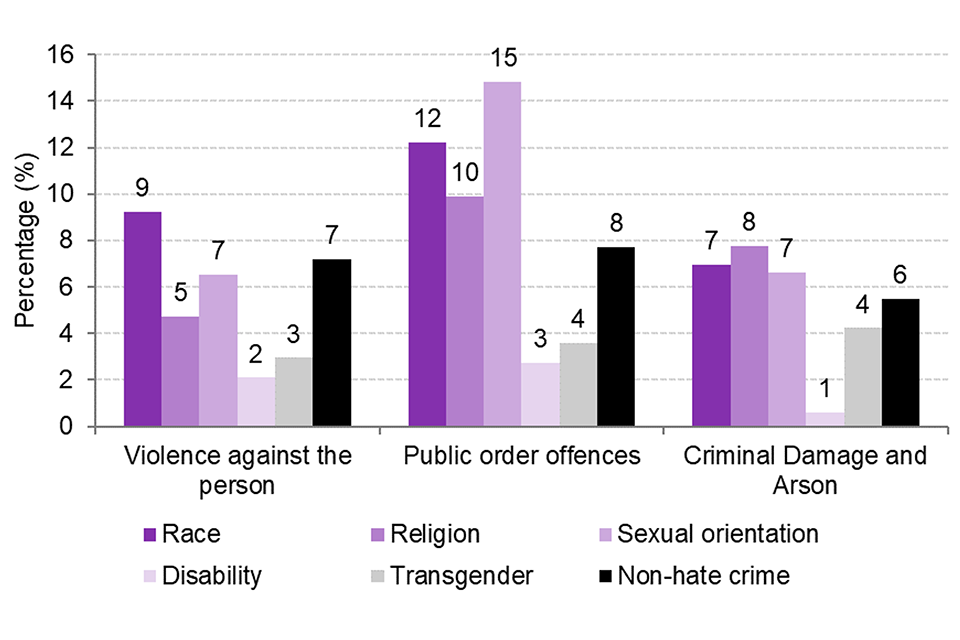
Source: Police recorded crime, Home Office Data Hub.
Figure 2.9 shows the median number of days taken to assign an outcome, from the date the crime was recorded, for selected hate crime and non-hate crime offences. Hate crime offences, on average, took longer to be assigned a final outcome than non-hate crime offences. For example, the median number of days taken to assign an outcome to criminal damage and arson hate crime offences was 24 days, compared with four days for non-hate crime offences. Similarly, it took longer to assign an outcome to violence against the person hate crime offences (median=39 days) than to non-hate crime flagged violent offences (median=20 days). This pattern is seen across the majority of outcomes, including charge or summons, evidential difficulty outcomes and investigation complete – no suspect identified. For example, it took on average 101 days to assign a charge for a violence against the person hate crime offence compared with 46 days for a violent offence that was not hate crime-related. This suggests more investigative effort being devoted to hate crime offences which reflects the serious nature of these crimes.
Figure 2.9: Median number of days taken to assign an outcome, hate crime flagged and non-hate crime flagged offences, outcomes recorded in year ending March 2021, 26 forces
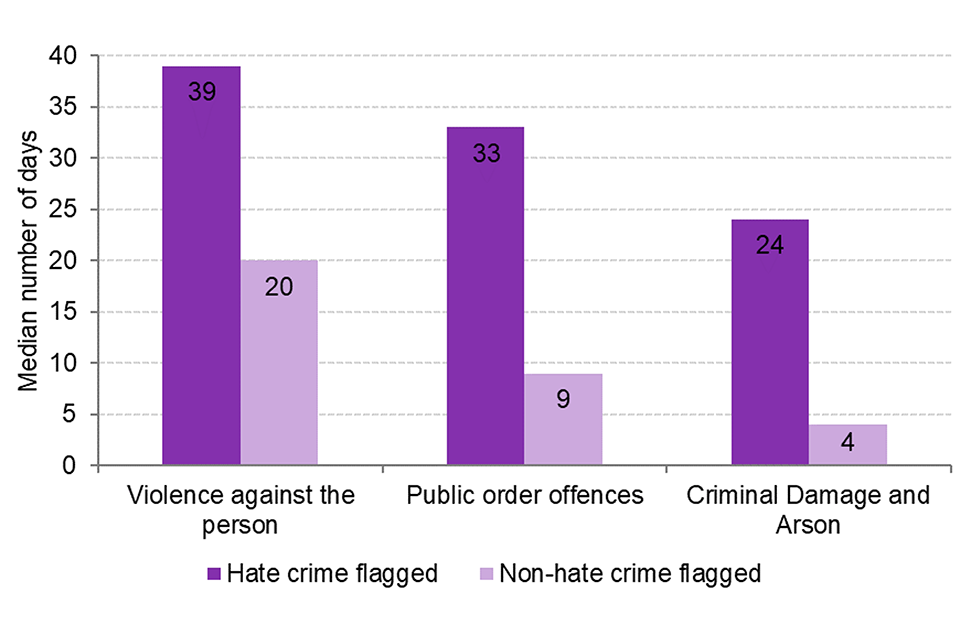
Source: Police recorded crime, Home Office Data Hub.
3. Police recorded hate crime data sources and quality
3.1 Introduction
In January 2014, the UK Statistics Authority published its assessment of ONS crime statistics. It found that statistics based on police recorded crime data, having been assessed against the Code of Practice for Official Statistics (now the Code of Practice for Statistics), did not meet the required standard for designation as National Statistics.
Police forces have made significant improvements in how they record crime since 2014. They have also improved their identification of what constitutes a hate crime over this time period. Because of these changes, police recorded crime figures do not currently provide reliable trends in hate crime. The figures do, however, provide a good measure of the hate crime-related demand on the police.
The UK Statistics Authority published a list of requirements for these statistics to regain the National Statistics accreditation. Some of the requirements of this assessment were to provide more detail on how data sources were used to produce these statistics, along with more information on the quality of the statistics. Additionally, there was a requirement to provide information on the process used by police forces to submit and revise data, and the validation processes used by the Home Office. To ensure that this publication meets the high standards required by the UK Statistics Authority, details are provided below.
3.2 Police recorded crime data sources and validation process
Hate crime data are supplied to the Home Office by the 43 territorial police forces of England and Wales, plus the British Transport Police. Greater Manchester Police have not been unable to supply data for year ending March 2020 following the implementation of a new IT system in July 2019; as such they have been excluded from any year-on-year comparisons.
Forces either supply the data at least monthly via the Home Office Data Hub (HODH) or on an annual basis in a manual return. For forces with data on the Data Hub, the Home Office extracts the number of offences for each force which have been flagged by forces as having been motivated by one or more of the monitored strands. Therefore, counts of hate crime via the HODH are dependent on the flag being used for each hate crime offence. It is then possible to derive the count of offences and the monitored strands covered.
In the manual return, police forces submit both the total number of hate crime offences (that is a count of the number of unique offences motivated by one or more of the five monitored strands) and the monitored strands (or motivating factors) associated with these offences. From year ending March 2016, police forces who returned data manually were required to provide an offence group breakdown for recorded hate crimes; prior to year ending March 2016 only an aggregated total of hate crimes for each of the five strands was asked for. It is possible for more than one of the monitored strands (motivating factors) to be assigned to a crime. For example, an offence could be motivated by hostility to race and religion, so would be counted under both strands but would only constitute one offence.
It is known that for some police forces, the addition of tags to crime records could be improved. For example, there may be crimes that are operationally treated as a hate crime but were not correctly identified as a hate crime on their crime recording system. In July 2018, HM Inspectorate of Constabulary and Fire & Rescue Services (HMICFRS) published a report on how the police deal with hate crime, including how crimes are flagged. Findings included a lack of recognition in forces about how important the flagging of hate crimes is and concerns around the lack of effective audit arrangements to check flags had been applied correctly.
The full report can be found here: Understanding the difference: the initial police response to hate crime.
In July 2021 the Government announced plans to publish an updated hate crime strategy this year. The strategy will outline plans on how the Government will work with the police and other law enforcement agencies to deliver improvements in the police response to hate crime.
Further information on how the police record hate crime can be found in the College of Policing’s Authorised Professional Practice guidance on hate crime publication launched in October 2020.
At the end of each financial year, the Home Office carry out a series of quality assurance checks on the hate crime data collected from the police forces (either by aggregate return or via the HODH).
These checks include:
- looking for any large or unusual changes in hate crimes from the previous year
- looking for outliers
- checking that the number of hate crimes by strand is higher than the total number of offences; where these two figures were the same, the force was asked to confirm they were recording multiple hate crime strands
Police forces are then asked to investigate these trends and either provide an explanation or resubmit figures where the reconciliation identifies data quality issues.
The data are then tabulated by monitored strand and year and sent back to forces for them to verify. At this stage, they are asked to confirm in writing that the data they submitted are correct and if they are not, then they have the opportunity to revise their figures.
From April 2016, the Home Office began collecting information from the police on the perceived religion of victims of religious hate crimes – that the religion targeted by the offender. While in the majority of offences the perceived and actual religion of the victim will be the same, in some cases this will differ. For example, if anti-Muslim graffiti is sprayed on a religious temple of another faith, this would be recorded as an offence of racially or religiously aggravated criminal damage and flagged by the respective police force as a religious hate crime against Muslims. This collection was voluntary in year ending March 2017 and made mandatory for year ending March 2018.
From April 2021, the Home Office has begun the collecting the ethnicity of the victims of racial hate crimes recorded by the police. These data will be published in forthcoming hate crime statistical bulletins.
The Home Office are also discussing with police forces the future experimental collection of data for crimes of violence against the person (including stalking and harassment) and sexual offences where the victim perceives it to have been motivated by a hostility based on their sex. The collection of these data will be revisited when the Law Commission’s review of hate crime legislation is published later this year.
5. Further information
Accompanying tables
The data tables can be found here:
Hate crime, England and Wales, 2020 to 2021
Other related publications
Previous hate crime statistical bulletins published by the Home Office are available here:
Hate crime statistics
The Office for National Statistics publishes quarterly publications on crime in England and Wales:
Crime and justice
Information on crime outcomes can be found here:
Crime outcomes in England and Wales statistics
Police recorded crime and outcomes Open Data Tables
The True Vision website contains more information about hate crime and how to report it
The Crown Prosecution Service website also carries information about hate crime, including policy and guidance and performance information, which can be found here:
CPS hate crime
The government’s plan for dealing with hate crime in England and Wales can be found here:
Hate crime action plan 2016 to 2020
Hate crime statistics for Northern Ireland can be found here:
Police Service of Northen Ireland: Hate motivation statistics
Hate crime statistics for Scotland for year ending March 2021 can be found here:
Hate Crime in Scotland 2020 to 2021
(figures published by the Scottish Government are based on the number of offenders charged, rather than police recorded crime)
Feedback and enquiries
We welcome feedback on the annual statistics release. If you have any feedback or enquiries about this publication, please contact Crime and Policing Statistics via crimeandpolicestats@homeoffice.gov.uk.
-
Forces may collect wider hate crime data; these are not centrally monitored by the Home Office. ↩
-
All year-on-year comparisons exclude Greater Manchester Police who were unable to provide data for year ending March 2020. ↩
-
HM Inspectorate of Constabulary and Fire & Rescue Services report: Crime recording: making the victim count. ↩
-
Estimation based upon data from 26 forces who supplied data to the Home Office Data Hub. ↩
-
The CSEW asks questions about whether an incident was deemed by the victim to be motivated by one of the five centrally monitored strands. Due to the low volume of hate crime incidents in the sample survey, the figures are not sufficiently robust to report for a single year of the CSEW. ↩
-
The combined year ending March 2018 to year ending March 2020 CSEW surveys estimated that 47% of hate crime offences came to the attention of the police. However, CSEW coverage of hate crime differs from crimes recorded by the police. For more details, see Hate Crime, England and Wales, 2019 to 2020. ↩
-
Includes cases where religion has been flagged as unknown. ↩
-
Although data from the main police recorded crime collection are sent to the Home Office broken down by month, the data are only quality assured with police forces on a quarterly basis. ↩
-
Avon and Somerset, Bedfordshire, Cheshire, Cleveland, Derbyshire, Devon and Cornwall, Dorset, Durham, Essex, Gloucestershire, Hampshire, Lincolnshire, Merseyside, Metropolitan Police, Norfolk, North Wales, North Yorkshire, Northumbria, South Wales, South Yorkshire, Suffolk, Surrey, Sussex, Thames Valley, West Mercia, West Yorkshire. ↩
-
These forces were: Avon and Somerset, Bedfordshire, Cheshire, Cleveland, Derbyshire, Devon and Cornwall, Dorset, Durham, Essex, Gloucestershire, Hampshire, Lincolnshire, Merseyside, Metropolitan Police, Norfolk, North Wales, North Yorkshire, Northumbria, South Wales, South Yorkshire, Suffolk, Surrey, Sussex, Thames Valley, West Mercia, West Yorkshire. ↩
-
Data were extracted June 2021. ↩
